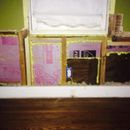Insulation in old home repair
Hello, I own a 1931 home. I had a window leak it damaged the plaster on an interior wall, roughly a 2’x5′ section. Behind the plaster and lath was a later of loose insulation and behind that bound newspaper. Much of the newspaper was rotted, as was a section of the wood behind it. The wood backed the exterior stucco. I removed the newspaper and wood. I am unable to replace the wood that backed the stucco.Instead and added 1″ rigid foam.
Here’s my question: What do I use next to insulate before I put on the sheetrock, faced or unfaced fiberglass…or something else? I live in Minneapolis.
Thanks for your help!
Tom
GBA Detail Library
A collection of one thousand construction details organized by climate and house part










Replies
Tom,
Your first concern should be ascertaining that you determined the water entry route. Were you able to flash the rough opening -- or at least flash the exterior of the window -- in a way that gives you confidence that the water entry problem has been solved? I hope so.
Assuming that you have done that, you can use almost any type of insulation in your wall cavities. The only potential problem is the ratio of rigid foam insulation to air-permeable insulation. In your climate zone (Zone 6), a 2x4 wall with exterior rigid foam must have foam with a minimum R-value of R-7.5. (For more information on this issue, see Calculating the Minimum Thickness of Rigid Foam Sheathing.)
The issue gets more complicated with a cut-and-cobble job like the one shown in your photo. (For more information on the cut-and-cobble approach, see Cut-and-Cobble Insulation.) Because the rigid foam takes up some of the 3.5-inch thickness of the cavity, the ratio between rigid foam and air-permeable insulation skews in the direction of safety -- so your R-5 foam is probably relatively safe.
The bottom line: to be really safe, you could double up the rigid foam using the cut-and-cobble method, to get an R-10 foam layer, and then fill the rest of the cavity with unfaced fiberglass insulation (you can split a batt to get thinner layers of fiberglass if you need to). Or to keep things simple, you could just fill up the cavities with unfaced fiberglass. Either way should work.
Thanks Martin! I did find the source of the water (window) and believe I have it fixed. What you say makes sense, and I'll read through the cut-and-cobble section, but I one more question:
Should I remove the newspaper insulation that is still in the two sections on the right? I only took out what was rotting, which in the two left sections was all of the paper, but in the right, I only removed 50%. Should I cut it all out and replace it with the foam and unfaced fiberglass?
Thanks!
Tom
Tom,
I'm not sure what you mean by "newspaper insulation" -- whether you are referring to the cellulose insulation visible in the bottoms of the stud bays, or some type of obsolete insulation that looks dark brown in the photos.
In either case, as long as the insulation is dry, there is no need to remove it.
When you install gypsum drywall or plaster on this wall, pay attention to airtightness, especially around the electrical boxes, and everything will be fine.
Hi Martin. By newspaper I mean actual newspaper. That "obsolete insulation that looks dark brown" that you mention is newspaper. Behind the celulose and against the exterior outside wall is a layer of bundled and sewn newspaper with a (once) water resistant paper on the outside. That's the brown stuff. It was 1931 and I assume they were trying to save a little money during the depression...I guess saving heat it wasn't a high priority. It's a good read though! I did remove it, doubled up on the foam and filled the rest with unfaced fiberglass. Oh. In case your a football fan, I threw in a pic from the paper of a diagram of one of Knute Rockne's favorite plays!
Tom,
It's always fun to discover old newspapers in walls... I've discovered some myself, and ended up stopping my work for some interesting reading.